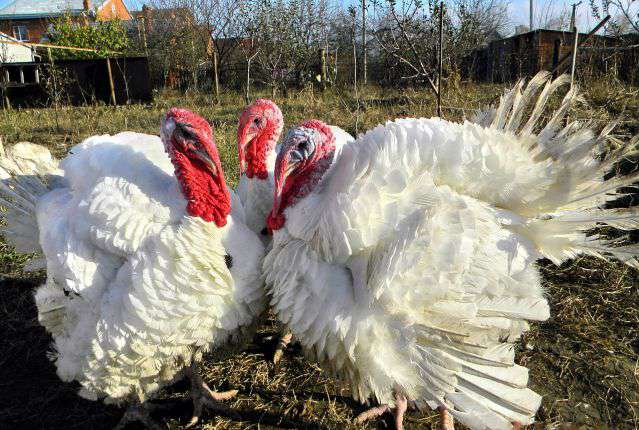
Characteristics of the BIG-6 turkey breed: features of their maintenance and breeding
To date, not many poultry farmers breed BIG-6 turkeys. This is possible due to the fact that not everyone knows about the peculiarities of caring for this unpretentious and precocious bird. In addition to dietary meat, you can also get feathers, fluff, and eggs from turkeys. By breeding this bird, you can always have a turkey on the table for Christmas and get a good income.
Contents
Characteristics of the BIG-6 cross
BIG-6 turkeys among all types of turkeys are champions in body weight. This bird ideal for home breeding.
- Large and massive BIG-6 turkeys have a stocky body, a small head and white, lush plumage. A fluffy bird looks like a big fluffy ball.
- Cross-country down is soft and light, so it is very much appreciated.
- On the head and neck, males have well-developed ornaments in the form of bright red earrings and a beard.
- The back of the turkeys is even, long, the chest is wide, convex.
- Birds have large wings and powerful, thick legs.
The average weight of the male of this cross is about twenty-three to twenty-five kilograms. Females usually weigh about eleven kilograms.
Turkey BIG-6 and its productive characteristics
In terms of the output of the total mass among all poultry and animals, this breed of turkeys is the champion.
- Of the total mass of the bird, the output of the muscle part is almost eighty percent.
- For a year of fattening, the male of the White Broad-breasted breed is able to gain twenty kilograms of weight. Turkeys of the breeds “Bronze North Caucasian”, “Black Tikhoretskaya”, “Silver North Caucasian” gain up to fifteen and a half kilograms. Male cross BIG-6 for one hundred and forty-two days of life can gain more than nineteen kilograms of weight.
- At three months, the average weight of a bird is three and a half, and at five – twelve kilograms.
Due to the high percentage of net weight yield, it is very profitable to keep turkeys of this breed.
Conditions of detention
Poultry house for turkeys BIG-6 should be built according to the number of chicks and the selected stocking density.
- Two-month-old chicks should have no more than ten heads per square meter of premises, adult birds in the same area – one – one and a half heads.
- For turkeys, dry bedding should be prepared, which should be renewed every year.
- The poultry house must be provided with boxes, which must be filled with a sand-ash mixture.
- When there is no bird in the room, it must be ventilated. In winter, this should be done carefully, only when there is no severe frost and wind outside.
Before settling turkeys in the poultry house, it should be disinfected, warmed up and equipped with feeders and drinkers.
Veterinary supply
In the technology of growing turkeys BIG-6, this aspect occupies a special place. In order for the birds not to get sick, it is necessary comply with certain conditions their content.
- Turkey poults should be reared separately from the adult herd and in no case be kept with other bird species.
- You can not feed BIG-6 turkey poults with low-quality feed.
- Drinking bowls and feeders must be protected from droppings, dust and various debris.
- In the room where the birds are kept, there should be no drafts and dampness.
- Bedding should always be dry and clean.
- Contact of turkey poults with wild birds should be excluded. This can be stressful for them.
Before landing turkeys, a poultry house is a must treat with slaked lime, formaldehyde vapor or iodine balls.
Feed for cross-country BIG-6
Feed must be prepared approximately two days before the poults are planted.
- The chick feeder must be of the appropriate size.
- You need to fill it with food immediately before the birds disembark, so that the food does not have time to collapse under the hot brooder.
- Do not place feeders near heat sources.
- In the first three to four weeks, BIG-6 turkey poults should be fed complete balanced feed. They should contain micro and macro elements, vitamins and amino acids. It is best to choose food from large, already proven manufacturing companies.
- Turkey poults begin to become interested in food by the end of the second day of life. At this time, they can be given a boiled, chopped egg and millet. To stimulate digestion, the egg can be sprinkled with crushed cereals.
- On the third day, grated carrots are added to the chicken feed, on the fourth – chopped greens.
- In the following days, fish and meat and bone meal, yogurt, skim milk, cottage cheese, and powdered milk can be added to the diet of turkeys.
- Turkey poults are prone to intestinal disorders, so they need to be fed only with fresh and high-quality products.
- Greens should always be present in the diet of young animals. However, too much of it should not be given, as the coarse fibers of the grass can clog the intestines of the bird. Therefore, it is recommended to add cabbage leaves, nettles, clover, beets with tops, carrots to the feed.
- Grown up turkeys are fed with wet mash, which must be treated very carefully. It is necessary to ensure that the mixers are not sticky and crumble in your hand.
- In the evening, young animals need to be given crushed and whole grains of barley, wheat, and corn.
- In summer, turkeys should be released for free grazing, and in winter they should be fed with dried leaves and hay.
Wet and dry food poured into different feeders. Mixers are prepared twenty minutes before they are fed, and dry food is added as the feeders are empty.
Cultivation of turkeys BIG-6
Young turkeys begin to rush from seven to nine months. At this time, you need to make sure that the eggs in the nest do not accumulate, and pick them up on time.
- Eggs are placed pointed end down and stored at a temperature of ten to fifteen degrees. Every ten days they need to be turned over.
- For four to five turkeys, one spacious nest will suffice, in which the bird should be placed freely.
- The nest should have sides and soft litter. You can’t put it on the floor.
- It is recommended to plant a turkey on eggs at the onset of a ten-hour daylight hours.
- Most often, a mother hen plants eggs within twenty-six to twenty-eight days.
- Turkeys should be grown on a dry, clean bedding, in conditions of good lighting and heating.
- In the first five days, the air temperature should be at least thirty-three degrees Celsius, then twenty-seven, and after eleven days of life of turkeys, twenty-three degrees.
- In order to prevent injury to the beak of chickens, it is recommended to feed them from cloth or a thick sheet of paper in the first days of life.
The poultry house must be equipped with special drinkersin which turkey poults cannot fall and get wet. Until the age of one month, they are very afraid of dampness.
Prevention of infectious diseases
To increase immunity, prevent stress and infectious diseases, turkeys are recommended solder with various vitamins and medicines.
- From the sixth to the eleventh day they need to drink an antibiotic. To do this, five grams of tilazin or tilane are diluted in ten liters of water. A month later, the procedure will be tedious to repeat.
- From a week old, turkey poults should be drunk with vitamin D 3 for ten days. After fifty days, repeat the intake of vitamins.
- For the prevention of aspergillosis for three days, one gram of nystatin is added to ten kilograms of feed. After that, the bird should be drunk with metronidazole (half a tablet per liter of water).
After the use of antibiotics, turkey poults need to drink vitamin-amino acid complex “Chiktonik”.
In order to have the main dish of this holiday on the Christmas table, the best time to hatch young turkeys is the middle of summer. Therefore, at this time, the cultivation of the BIG-6 cross in personal farms is most active.





